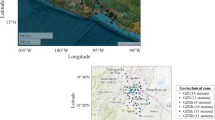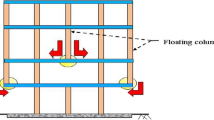Abstract
Shake table testing was performed to investigate the dynamic stability of a mid-dip bedding rock slope under frequent earthquakes. Then, numerical modelling was established to further study the slope dynamic stability under purely microseisms and the influence of five factors, including seismic amplitude, slope height, slope angle, strata inclination and strata thickness, were considered. The experimental results show that the natural frequency of the slope decreases and damping ratio increases as the earthquake loading times increase. The dynamic strength reduction method is adopted for the stability evaluation of the bedding rock slope in numerical simulation, and the slope stability decreases with the increase of seismic amplitude, increase of slope height, reduction of strata thickness and increase of slope angle. The failure mode of a mid-dip bedding rock slope in the shaking table test is integral slipping along the bedding surface with dipping tensile cracks at the slope rear edge going through the bedding surfaces. In the numerical simulation, the long-term stability of a mid-dip bedding slope is worst under frequent microseisms and the slope is at risk of integral sliding instability, whereas the slope rock mass is more broken than shown in the shaking table test. The research results are of practical significance to better understand the formation mechanism of reservoir landslides and prevent future landslide disasters.
Similar content being viewed by others
References
Almaz T and Havenith HB (2016), “2D Dynamic Studies Combined with the Surface Curvature Analysis to Predict Arias Intensity Amplification,” Journal of Seismology, 20(3): 711–731.
Aurelian CT, Toshitaka K and Roy CS (2009), “Earthquake-Induced Displacements of Gravity Retaining Walls and Anchor-Reinforced Slopes,” Soil Dynamics and Earthquake Engineering, 29(3): 428–437.
Aydan Ö, Ohta Y, Geniş M, Tokashiki N and Ohkubo K (2010), “Response and Stability of Underground Structures in Rock Mass during Earthquakes,” Rock Mechanics and Rock Engineering, 43(6): 857–875.
Barbero M and Barla G (2010), “Stability Analysis of a Rock Column in Seismic Conditions,” Rock Mechanics and Rock Engineering, 43(6): 845–855.
Bhasin R and Kaynia AM (2004), “Static and Dynamic Simulation of a 700-m High Rock Slope in Western Norway,” Engineering Geology, 71(3): 213–226.
Chen D, Wang Y and Zeng X (2008), “A Study of Reservoir-Induced Earthquake of Three Gorges Project,” Chinese Journal of Rock Mechanics and Engineering, 27(8): 1513–1524.
Chen Z, Hu X and Xu Q (2016), “Experimental Study of Motion Characteristics of Rock Slopes with Weak Intercalation under Seismic Excitation,” Journal of Mountain Science, 13(3): 546–556.
Deng Z, Liu X, Liu Y, Liu S, Han Y, Tu Y, and Gu J (2020), “Cumulative Damage Evolution and Failure Modes of the Bedding Rock Slope Under Frequent Microseisms,” Arabian Journal of Geosciences, 13(10).
Dong J, Yang J, Wu F, Wang D and Yang G (2010), “Research on Collapse of High Cutting Slope with Horizontal Soft-Hard Alternant Strata in Three Gorges Reservoir Area,” Rock and Soil Mechanics, 31(1): 151–157.
Fan G, Zhang J, Wu J and Yan K (2016), “Dynamic Response and Dynamic Failure Mode of a Weak Intercalated Rock Slope Using a Shaking Table,” Rock Mechanics and Rock Engineering, 49(8): 3243–3256.
Gibson MD, Wartman JP, MacLaughlin MM and Keefer DK (2018), “Pseudo-Static Failure Modes and Yield Accelerations in Rock Slopes,” International Journal of Rock Mechanics and Mining Sciences, 102: 1–14.
Huang J, Zhao M, Xu C, Du X, Jin L and Zhao X (2018), “Seismic Stability of Jointed Rock Slopes Under Obliquely Incident Earthquake Waves,” Earthquake Engineering and Engineering Vibration, 17(3): 527–539.
Itasca Consulting Group Inc (2014), “UDEC (Universal Distinct Element Code), Version 6.00,” Software, Minneapolis, USA.
Jiang J (2012), “Research on the Deformation Mechanism and Dynamic Response of Typical Landslides in Three Gorges Reservoir in Case of Frequent Microseisms,” Dissertation, China University of Geosciences. (in Chinese)
Koukouvelas I, Litoseliti A, Nikolakopoulos K and Zygouri V (2015), “Earthquake Triggered Rock Falls and Their Role in the Development of a Rock Slope: the Case of Skolis Mountain, Greece,” Engineering Geology, 191: 71–85.
Kundu J, Sarkar K and Singh TN (2017), “Static and Dynamic Analysis of Rock Slope — A Case Study,” Procedia Engineering, 191: 744–749.
Kveldsvik V, Kaynia AM, Nadim F, Bhasin R, Nilsen B and Einstein HH (2009), “Dynamic Distinct-Element Analysis of the 800m High Åknes Rock Slope,” International Journal of Rock Mechanics and Mining Sciences, 46(4): 686–698.
Lak M, Baghbanan A and Hashemolhoseini H (2017), “Effect of Seismic Waves on the Hydro-Mechanical Properties of Fractured Rock Masses,” Earthquake Engineering and Engineering Vibration, 16(3): 525–536.
Li D, Liu X, Li X and Liu Y (2016), “The Impact of Microearthquakes Induced by Reservoir Water Level Rise on Stability of Rock Slope,” Shock and Vibration, 2016(2): 1–13.
Li L, Ju N, Zhang S and Deng X (2017), “Shaking Table Test to Assess Seismic Response Differences Between Steep Bedding and Toppling Rock Slopes,” Bulletin of Engineering Geology and the Environment, 29(3): 1–9.
Li Y and Huang G (2008), “Some Thoughts on Reservoir-induced Earthquakes,” Technology for Earthquake Disaster Prevention, 3(1): 61–71. (in Chinese)
Lin Y, Zhu D, Deng Q and He Q (2012), “Collapse Analysis of Jointed Rock Slope Based on UDEC Software and Practical Seismic Load,” Procedia Engineering, 31: 441–446.
Liu H, Xu Q and Fan X (2012), “Influence of Ground Motion Intensity on Dynamic Response Laws of Slope Accelerations,” Rock and Soil Mechanics, 33(5): 1357–1365. (in Chinese)
Liu H, Xu Q and Xu H (2011), “Shaking Table Model Test on Slope Dynamic Deformation and Failure,” Rock and Soil Mechanics, 32(s2): 334–339. (in Chinese)
Liu H, Xu Q and Li Y (2014), “Effect of Lithology and Structure on Seismic Response of Steep Slope in a Shaking Table Test,” Journal of Mountain Science, 11(2): 371–383.
Liu Q, Wu Z and Lee V W (2019), “Scattering and Reflection of SH Waves Around a Slope on an Elastic Wedged Space,” Earthquake Engineering and Engineering Vibration, 18(2): 255–266.
Liu X, Han Y, Li D, Tu Y, Deng Z, Yu C and Wu X (2019), “Anti-Pull Mechanisms and Weak Interlayer Parameter Sensitivity Analysis of Tunnel-Type Anchorages in Soft Rock with Underlying Weak Interlayers,” Engineering Geology, 253: 123–136.
Liu X, He C, Liu S, Liu Y, Lu Y and Liu Z (2018a), “Dynamic Response and Failure Mode of Slopes with Horizontal Soft and Hard Interbeddings Under Frequent Microseisms,” Arabian Journal for Science and Engineering, doi:https://doi.org/10.1007/s13369-018-3143-0.
Liu X, Liu Y, He C and Li X (2018b), “Dynamic Stability Analysis of the Bedding Rock Slope Considering the Vibration Deterioration Effect of the Structural Plane,” Bulletin of Engineering Geology and the Environment, 77(1): 87–103.
Liu X, Liu Y, Lu Y, Li X and Li P (2017), “Numerical Analysis of Evaluation Methods and Influencing Factors for Dynamic Stability of Bedding Rock Slope,” Journal of Vibroengineering, 19(3): 1937–1961.
Liu Y, Li H, Xiao K, Li J, Xia X and Liu B (2014), “Seismic Stability Analysis of a Layered Rock Slope,” Computers and Geotechnics, 55: 474–481.
Liu Y, Li H, Zhao J, Li J and Zhou Q (2004), “Udec Simulation for Dynamic Response of a Rock Slope Subject to Explosions,” International Journal of Rock Mechanics and Mining Sciences, 41: 599–604.
Luo G, Hu X, Gu C and Wang Y (2012), “Numerical Simulations of Kinetic Formation Mechanism of Tangjiashan Landslide,” Journal of Rock Mechanics and Geotechnical Engineering, 4(2): 149–159.
Lysmer J and Kuhlemeyer RL (1969), “Finite Dynamic Model for Infinite Media,” Journal of the Engineering Mechanics Division, 95: 859–878.
Napier JAL and Peirce AP (1997), “The Use of a Multipole Expansion Technique to Analyze Large Scale Fracture Processes and Seismic Recurrence Effects in Deep Level Mines,” International Journal of Rock Mechanics and Mining Sciences, 34(3/4): 680–691.
Pal S, Kaynia AM, Bhasin RK and Paul DK (2012), “Earthquake Stability Analysis of Rock Slopes: a Case Study,” Rock Mechanics and Rock Engineering, 45(2): 205–215.
Qin J and Qian X (2008), “The Relation Between Acceleration and Intensity of Reservoir Induced Earthquake,” Seismological and Geomagnetic Observation and Research, 29(3): 1–9.
Song D, Che A, Zhu R and Ge X (2018), “Dynamic Response Characteristics of a Rock Slope with Discontinuous Joints under the Combined Action of Earthquakes and Rapid Water Drawdown,” Landslides, 15(6): 1109–1125.
Sun G, Yang Y, Jiang W and Zheng H (2017), “Effects of an Increase in Reservoir Drawdown Rate on Bank Slope Stability: A case Study at the Three Gorges Reservoir, China,” Engineering Geology, 221: 61–69.
Tang C, Zhu J and Liang J (2009), “Emergency Assessment of Seismic Landslide Susceptibility: a Case Study of the 2008 Wenchuan Earthquake Affected Area,” Earthquake Engineering and Engineering Vibration, 8(2): 207–217.
Tang L, Cong S, Ling X and Ju N (2017), “The boundary conditions for Simulations of a Shake-Table Experiment on the Seismic Response of 3D Slope,” Earthquake Engineering and Engineering Vibration, 16(1): 23–32.
Xiong M and Huang Y (2017), “Stochastic Seismic Response and Dynamic Reliability Analysis of Slopes: A Review,” Soil Dynamics and Earthquake Engineering, 100: 458–464.
Yang G, Ye H and Wu F (2012), “Shaking Table Model Test on Dynamic Response Characteristics and Failure Mechanism of Anti-Dip Layered Rock Slope,” Chinese Journal of Geotechnical Engineering, 31(11): 2214–2221.
Yang JL (2014), “Study on Rock and Soil Mechanics Parameters Partition of Landslides in the Three Gorges Reservoir,” Dissertation, Chongqing Jiaotong University. (in Chinese)
Yang T, Xu T, Liu H, Zhang C, Wang S, Rui Y and Shen L (2014), “Rheological Characteristics of Weak Rock Mass and Effects on the Long-Term Stability of Slopes,” Rock Mechanics and Rock Engineering, 47: 2253–2263.
Zaei ME and Rao KS (2017), “Evaluating the Effect of Strong Earthquake on Slope Instability,” Procedia Engineering, 173: 1771–1778.
Zhang B, Yang C, McVerry GH (2010), “Earthquake-Induced Landslide Displacement Attenuation Models and Application in Probabilistic Seismic Landslide Displacement Analysis,” Earthquake Engineering and Engineering Vibration, 9(2): 177–187.
Acknowledgement
The authors acknowledge the financial support provided by the National Natural Science Foundation of China (No. 41372356), the Basic Research and Frontier Exploration Project of Chongqing, China (cstc2018jcyjA1597), the College Cultivation Project of the National Natural Science Foundation of China (No. 2018PY30) and the Graduate Scientific Research and Innovation Foundation of Chongqing, China (No. CYS18026).
Author information
Authors and Affiliations
Corresponding author
Additional information
Supported by
National Natural Science Foundation of China under Grant No. 41372356, the Basic Research and Frontier Exploration Project of Chongqing, China under Grant No. cstc2018jcyjA1597, the College Cultivation Project of the National Natural Science Foundation of China under Grant No. 2018PY30 and the Graduate Scientific Research and Innovation Foundation of Chongqing, China under Grant No. CYS18026
Rights and permissions
About this article
Cite this article
Deng, Z., Liu, X., Liu, Y. et al. Model test and numerical simulation on the dynamic stability of the bedding rock slope under frequent microseisms. Earthq. Eng. Eng. Vib. 19, 919–935 (2020). https://doi.org/10.1007/s11803-020-0604-8
Received:
Accepted:
Published:
Issue Date:
DOI: https://doi.org/10.1007/s11803-020-0604-8




